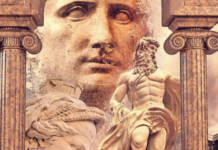
Imagine you are walking down the road of your hometown. You blink and suddenly you have crossed into a whole new world. Well, I should say an ancient world. You’re wearing a linen tunic, with an ornate gold belt. You are now a man, in his 20s (based on the look of your new body). You hear a lyre playing in the distance, and the smell of herbs hangs in the air. Fires are crackling and dancing from the tops of pillars, marking the entrance to the grand Acropolis. It is 400 BC, and the Acropolis is a representation of the grandeur of Greece.
You are walking slowly, your head turning side to side, trying to see everything everywhere. Finally, you settle your gaze ahead to see a man walking briskly in front of you. You narrow your eyes to get a better look and gasp when you realize that this man is one of the greatest philosophers of all time. The moment you realize who it is, you are whisked away.
A breeze turns to a gust and you shield your face with your hands. When you drop your hands, you see that you are now in a grand room, white marble all around. There are thousands of men, young and old, all around. Their ornate jewellery and fine tunics tell you that they are men of nobility.
In their hands are two stones — you look down and see that you, too, are holding two stones: one black, for no, one white, for yes. Greece is the birthplace of democracy. It was true democracy, as the men of the country voted on everything (as true as possible, anyways, without including the voice of women, slaves, or peasants). You are shuffled into line, slowly moving closer to the pedestal at the front of the room. Men are dropping their stone in to a large basin, casting their vote. Now it’s your turn; how do you cast?
This may sound like a terrific way to connect to ancient Greece, but this is how creativity inspires Kostas of Mistiis.com. Born and raised in Athens, Kostas wanders the city of his birth, and when he crosses the threshold of ancient temples and monasteries, he has one foot in this world, and one foot in the past. His psychic connection to his beloved city is how he brings historic figures to life (that, and rigorous study of historical facts and manuscripts). What drew me to Kostas was the psychic energy of his work. From a simple Google search for occult artists, I was led to Mistiis.com, and was mesmerized by the work. The amount of emotion that radiated through the screen was overwhelming for an intuitive like myself.
Beauty of the beast
As I was scrolling through the prints Kostas has posted on his website, I was stopped by an alluring woman, whose blank eyes captured me. The expression on her face is one of love and lust. When I finally broke free from her eyes, I realized I was looking at a portrayal of Medusa, the Gorgon. When you think of Medusa, you think of a wretched monster with snakes for hair and a look that kills (literally). I searched the Internet, and no other paintings or depictions of this mythical being portray her as a seductive beauty.
For those of you who may not know the tale, Medusa came to life in Hesiod’s Theogony. She is one of three sisters born to Gorgons, Ceto and Phorcys. She was the only mortal, with alluring blue eyes and gorgeous golden locks. Medusa grew up to be a priestess of Athena, vowing to spend her days in the temple of the mighty goddess.
Greek gods are known for their ability to seduce humans, and Medusa was no different. Poseidon wooed Medusa, who broke her vows, left the temple and married him. Athena was enraged at this betrayal, and as a punishment for her abandonment, Medusa was cursed. Her hair and eyes, once so beautiful even gods could not resist her, were transformed. Her golden hair turned to poison snakes, and her incredible eyes became ugly, bulging, lethal orbs in her disfigured, green skinned face.
Heartbroken and miserable, Medusa left Greece. She fled to Africa, with her poisonous snakes dropping from her head as she wandered. This is why, according to the ancient Greeks, Africa is so full of poisonous snakes. Kostas restored Medusa to the beauty she once was on canvas.
I told Kostas my thoughts on Medusa and he replied, “I always wanted to paint the mythical creature Medusa and after many sketches I decided to create a female “monster” and not an evil woman.”

When I read that in his email I smiled to myself. All too often, monsters are associated with evil, but that is done from fear of the unknown. We don’t know what it is, and are so worried about how much more powerful it is that we don’t stop to think about what it wants.
We come to the same conclusions about animals in the wild. The bear or snake came after us, so therefore the animal is dangerous and must be killed, right? What if the bear had cubs just around the corner, and thought you were coming to hurt them? What if the snake saw only an intruder in its territory? If someone you don’t know walks into your home, wouldn’t you be scared? Wouldn’t you defend yourself, and your home?
Medusa was turned into a monster simply because she couldn’t help who she loved. She killed men not because she wanted to, but because a jealous goddess made it so a glance from Medusa’s once beautiful eyes was deadly.
Vulnerability beneath viciousness
Medusa wasn’t the only monster who Kostas found the heart of. The name Caligula is infamous, and even those who did poorly in history class (ahem, like me) recognize the name. He was an emperor of Greece and far from gentle or fair. He was assassinated for his blood lust. Even though his body died, his memory has lived on.
However, when I look at Kostas’ portrayal of Caligula, I see an insecure, slightly frightened man who is unsure of what he’s doing. Kostas saw the vulnerable side to a man who killed his own kin. When I wonder how it was he accomplished this, I always come to the conclusion that Kostas saw this side when he was exploring ruins of Greece, tapping into the ancient energies left behind by these historic figures. Kostas’ gift to see beyond the veil, his ability to hear what most cannot, and his pure talent, resulted in this empathy-provoking painting.

Artist profile
Kostas is undeniably an incredible artist. Through a number of email correspondences, I was able to learn more about this talented Athenian. Kostas studied at the School of Byzantine Hagiography, but considers himself a self-taught artist. His preferred medium is colours made of natural pigments, made of dusts, oils, and acrylics on canvas and paper. I asked him if anything in particular inspired his work and he replied that he was “profoundly influenced by ancient history and mythology (not only Greek). The Greek environment and civilization has been a source of inspiration for me.”
When I encouraged him to specify, especially in regard to which myths had a particular influence on his work, he responded, “I like Greek mythology! There are so many myths and legends! Theseus and the Labyrinth, Prometheus and the theft of fire, Perseus and Medusa, and the most amazing in Greek mythology is that all gods and heroes are actually mortals, with many problems and tragedies as any of us are.Of course, I love all civilizations and cultures and I am trying to read all about them.”
When I asked Kostas what it was about the Greek environment and civilization that inspired him he replied “I discover the realm of hidden and inexplicable.” Chills!
Kostas asked, “Can you imagine to walk at [sic] the same street that Plato and Aristotle walked in the past?” That night, as I laid in bed, I imagined what it would be like. I went on a guided journey, of sorts, that was quite similar to the imagery that opens this article. When I came back to the present, I scrambled out of bed, fighting off the blankets that wrapped themselves around my legs as if they were boa constrictors hugging their prey, to find a pen and paper so I could write about my experience before it dissolved from my memory. Despite the messy penmanship, I deciphered enough to help you imagine that as well.
Spirituality sparks creativity
I believe that Kostas’s spiritual practices help strengthen his connection to the ancient world around him. In the morning he sits in silence for 15-20 minutes meditating, and at the end of every day he tries water-based techniques to clear his energy. Simple, yet effective. Kostas didn’t specify any faith or tradition he adhered to, but he did give me an interesting lesson about my Greek stepmothers religion, Greek Orthodoxy. He told me that the Greek Orthodox church helped the revolution against the Ottoman Empire in 1821… “too many dead priests who became heroes.” How powerful is that imagery?
Kostas’ reverence for the ruins makes sight-seeing expeditions spiritual experiences, which bring his works to life. The respect and awe he holds for the land and history shines through his paintings. He says, “its magical! When I go to ancient theaters or temples and touch a
column,or a statue, and I know that is 2,500 years old. It’s an amazing feeling, and difficult to forget.”
Closing thoughts
When you think of Greece, you may think of democracy, or perhaps philosophy. I, too, think of these things and many more. I think of family, and support. I think of the encouragement to follow your dreams, and the belief that women are capable of anything men are (if not more). This could be just my family — although these ideas were portrayed in the movie My Big Fat Greek Wedding. (“The man may be the head of the family, but the woman is the neck and she can turn the head any way she likes!”) But, please, forgive me for stereotyping a culture, but it’s just what I think of. I believe Kostas feels the same, when the first source of inspiration he listed was Greek civilization.
I found Kostas’ work by chance, and a part of me feels that it was meant to be. The energy and emotion of his work is moving, invigorating, and, at times, bittersweet. I will leave you with a message from Kostas:
Ο ανθρώπινος εγκέφαλος είναι ένα απίθανο
μηχάνημα/μηχανισμός. Εφηύρε μια ιδέα που λέγεται «μέλλον»
The human brain is an incredible machine.It invented an idea called “the future.”
mistiis.com








